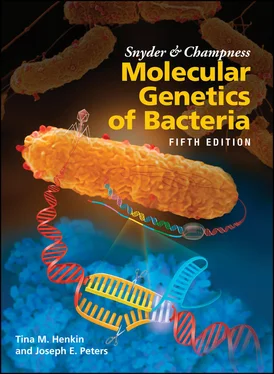To count the bacteria in a culture or to isolate a pure culture, it is often necessary to obtain discrete colonies of the bacteria. However, because bacteria are so small, a concentrated culture contains billions of bacteria per milliliter. If such a culture is plated directly on a petri plate, the bacteria all grow together, and discrete colonies do not form. Serial dilutionsoffer a practical method for diluting solutions of bacteria before plating to obtain a measurable number of discrete colonies. The principle is that if dilutions are repeated in succession, they can be multiplied to produce the total dilution. For example, if a solution is diluted in three steps by adding 1 ml of the solution to 99 ml of water (one in a hundred), followed by adding 1 ml of this dilution to another 99 ml of water, and finally, by adding 1 ml of the second dilution to another 99 ml of water, the final dilution is 10 –2x 10 –2x 10 –2= 10 –6, or one in a million. To achieve the same dilution in a single step, 1 ml of the original solution would have to be added to 1,000 liters (about 250 gallons) of water. Obviously, it is more convenient to handle three solutions of 100 ml each than to handle a solution of 250 gallons, which weighs about 2,000 lb!
Probably the greatest advantage of bacterial genetics is the opportunity to do selections, by which very rare mutants and other types of strains can be isolated. To select a rare strain, billions of the bacteria are plated under conditions in which only the desired strain, not the bulk of the bacteria, can grow. In general, these conditions are called the selective conditions. For example, a nutrient may be required by most of the bacteria but not by the strain being selected. Agar plates lacking the nutrient then present selective conditions for the strain, since only the strain being selected multiplies to form a colony in the absence of the nutrient. In another example, the desired strain may be able to multiply at a temperature that would kill most of the bacteria. Incubating agar plates at that temperature would provide the selective condition. After the strain has been selected, a colony of the strain can be picked and the colony purified away from other contaminating bacteria under the same selective conditions.
The power of selection with bacterial populations is awesome. Using a properly designed selection, a single bacterium can be selected from among bill ions placed on an agar plate. If we could apply such selections to humans, we could find one of the few individuals in the entire human population of Earth with a particular trait.
Storing Stocks of Bacterial Strains
Most types of organisms must be continuously propagated; otherwise, they age and die. Propagating organisms requires continuous transfers and replenishing of the food supply, which can be very time-consuming. However, many types of bacteria can be stored in a dormant state and therefore do not need to be continuously propagated. The conditions used for storage depend on the type of bacteria. Some bacteria sporulate and so can be stored as dormant spores. Others can be stored by being frozen in glycerol or by being dried. Storing organisms in a dormant state is particularly convenient for genetic experiments, which often require the accumulation of large numbers of mutants and other strains. The strains remain dormant until the cells are needed, at which time they can be revived. Organisms that are continually propagated will also accumulate mutations, a problem that is eliminated with the proper storage of bacteria.
Genetic experiments with an organism usually require some form of exchange of DNA or genes between members of the species. Most types of organisms on Earth are known to have some means of genetic exchange, which presumably accelerates evolution and increases the adaptability of a species.
Exchange of DNA from one bacterium to another can occur in one of three ways. In transformation, DNA released from one cell enters another cell of the same species (see chapter 6). In conjugation, discrete genetic elements transfer DNA from one cell to another (see chapter 5). Finally, in transduction, a bacterial virus accidentally picks up DNA from a cell it has infected and delivers this DNA into another cell (see chapter 7). The ability to exchange DNA between strains of a bacterium makes possible genetic crosses and complementation tests, as well as the tests essential to genetic analysis.
Some of the most important discoveries in genetics have come from studies with viruses that infect bacteria; these viruses are called bacteriophages, or phagesfor short (see chapter 7). Phages are not alive; instead, they are just genes wrapped in a protective coat of protein and/or membrane, as are all viruses. Because phages are not alive, they cannot multiply outside a bacterial cell. However, if a phage encounters a type of bacterial cell that is sensitive to that phage, the phage, or at least its DNA or RNA, enters the cell and directs it to make more phage.
Phages are usually identified by the holes, or plaques, they form in layers of sensitive bacteria. In fact, the name “phage” (Greek for “eat”) derives from these plaques, which look like eaten-out areas. A plaque can form when a phage is mixed with large numbers of susceptible bacteria and the mixture is placed on an agar plate. As the bacteria multiply, one bacterial cell may be infected by the phage, which multiplies and eventually breaks open, or lyses, the bacterium, releasing more phage. As the surrounding bacteria are infected, the phage spread, even as the bacteria multiply to form an opaque layer called a bacterial lawn. Wherever the original phage infected the first bacterium, the plaque disrupts the lawn, forming a clear spot on the agar. Despite its empty appearance, this spot contains millions of the phage.
Phages offer many of the same advantages for genetics as bacteria. Thousands or even millions of phages can be put on a single plate. Also, like bacterial colonies, each plaque contains millions of genetically identical phage. By analogy to the colony purification of bacterial strains, individual phage mutants or strains can be isolated from other phages through plaque purification.
Phages are, in a sense, haploid, since they usually have only one copy of each gene. As with bacteria, this property makes isolation of phage mutants relatively easy, since all mutants immediately exhibit their phenotypes without the need for backcrosses.
Selection of rare strains of a phage is possible; as with bacteria, it requires conditions under which only the desired phage strain can multiply to form a plaque. For phages, these selective conditions may be a bacterial host in which only the desired strain can multiply or a temperature at which only the phage strain being selected can multiply. Note that the bacterial host must be able to multiply under the same selective conditions; otherwise, a plaque cannot form.
As with bacteria, selections allow the isolation of very rare strains or mutants. If selective conditions can be found for the strain, mill ions of phages can be mixed with the bacterial host, and only the desired strain multiplies to form a plaque. A pure strain can then be obtained by picking the phage from the plaque and purifying the phage strain under the same selective conditions.
Читать дальше











